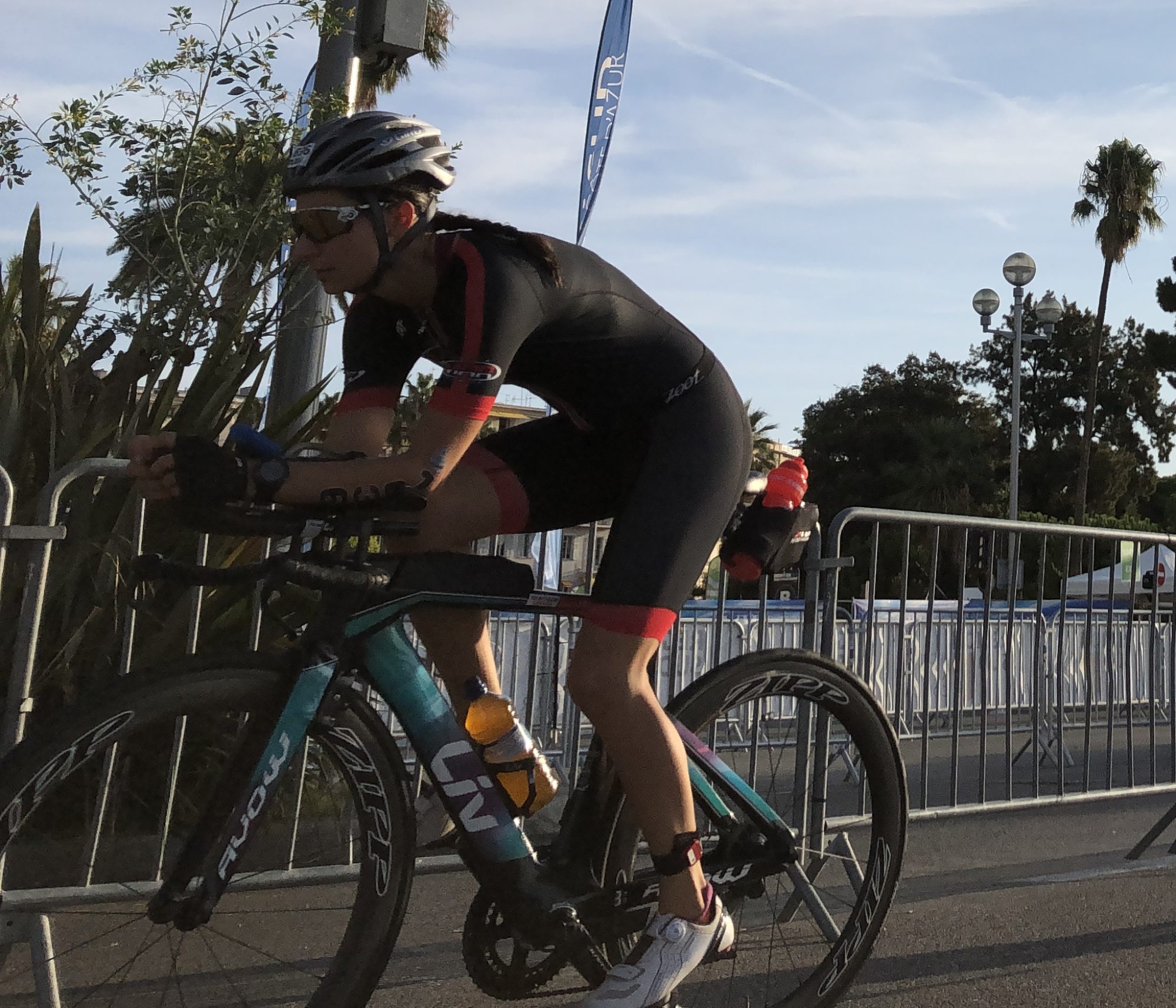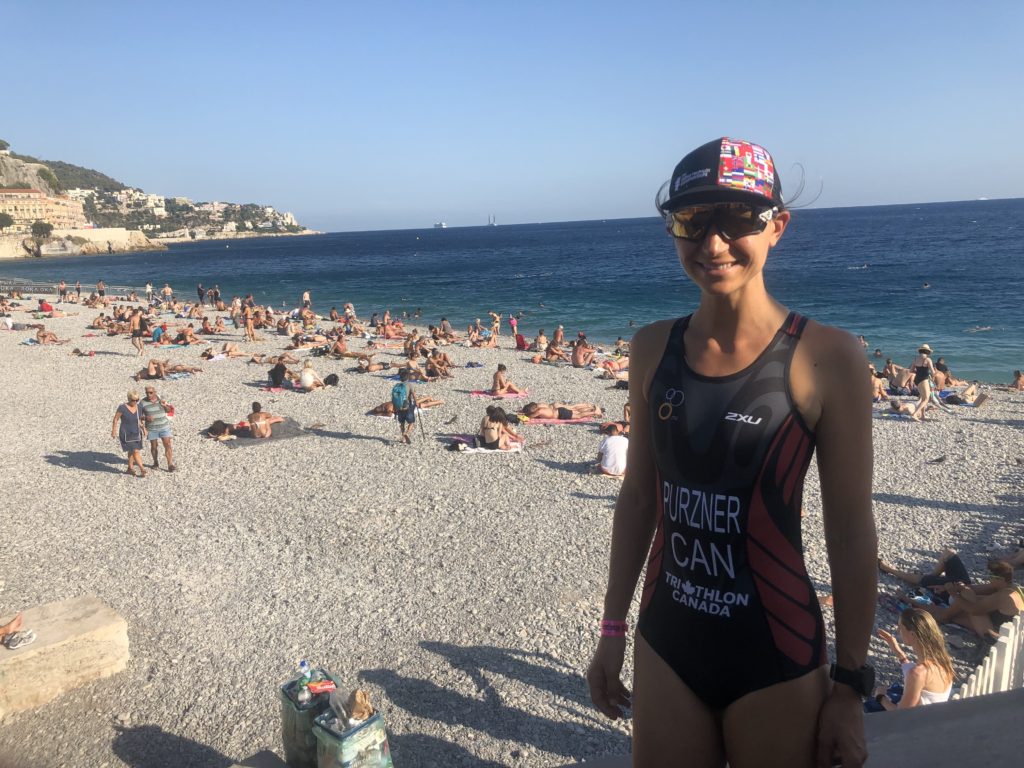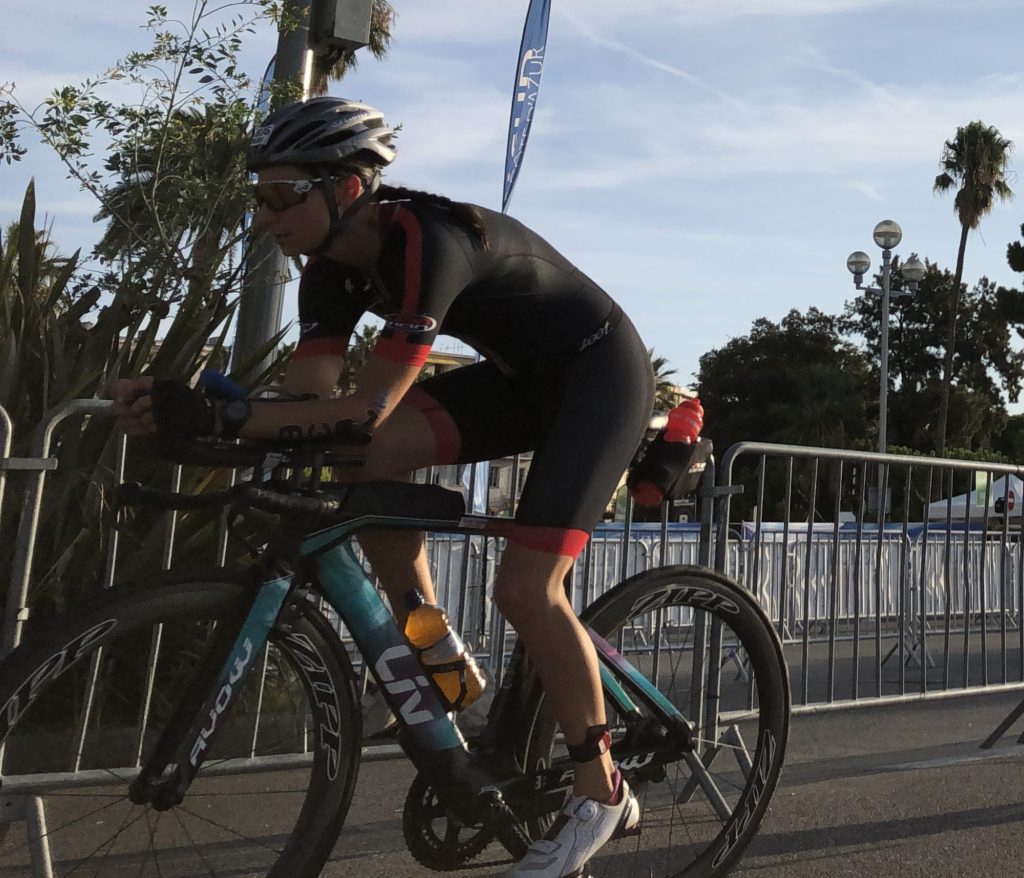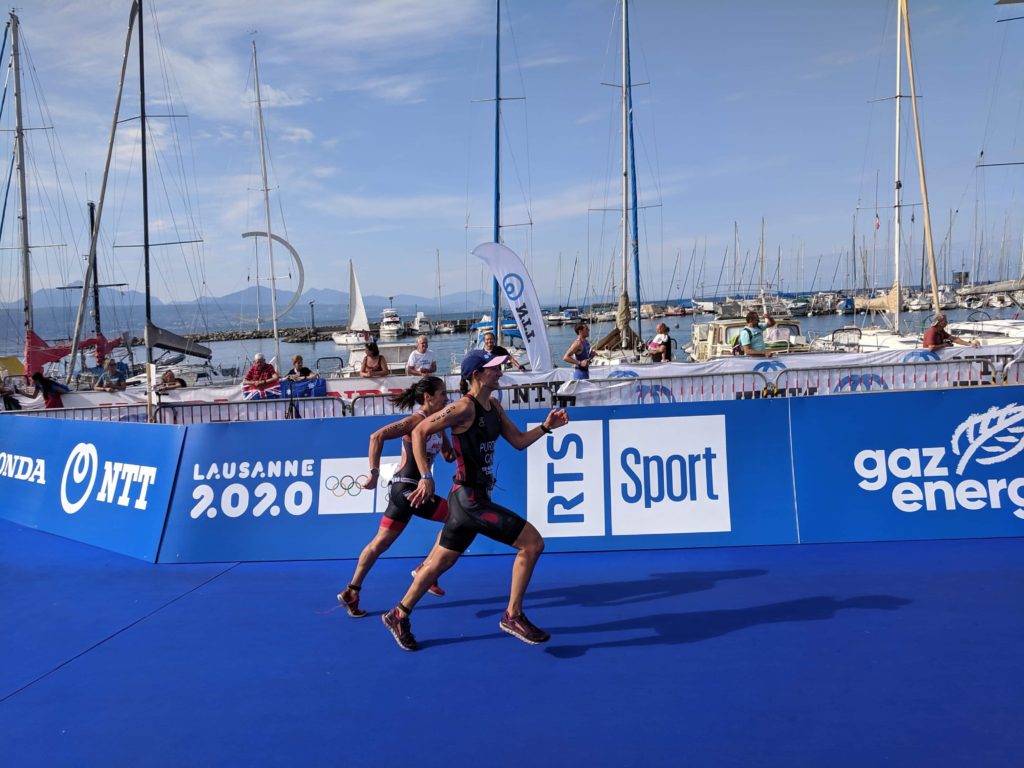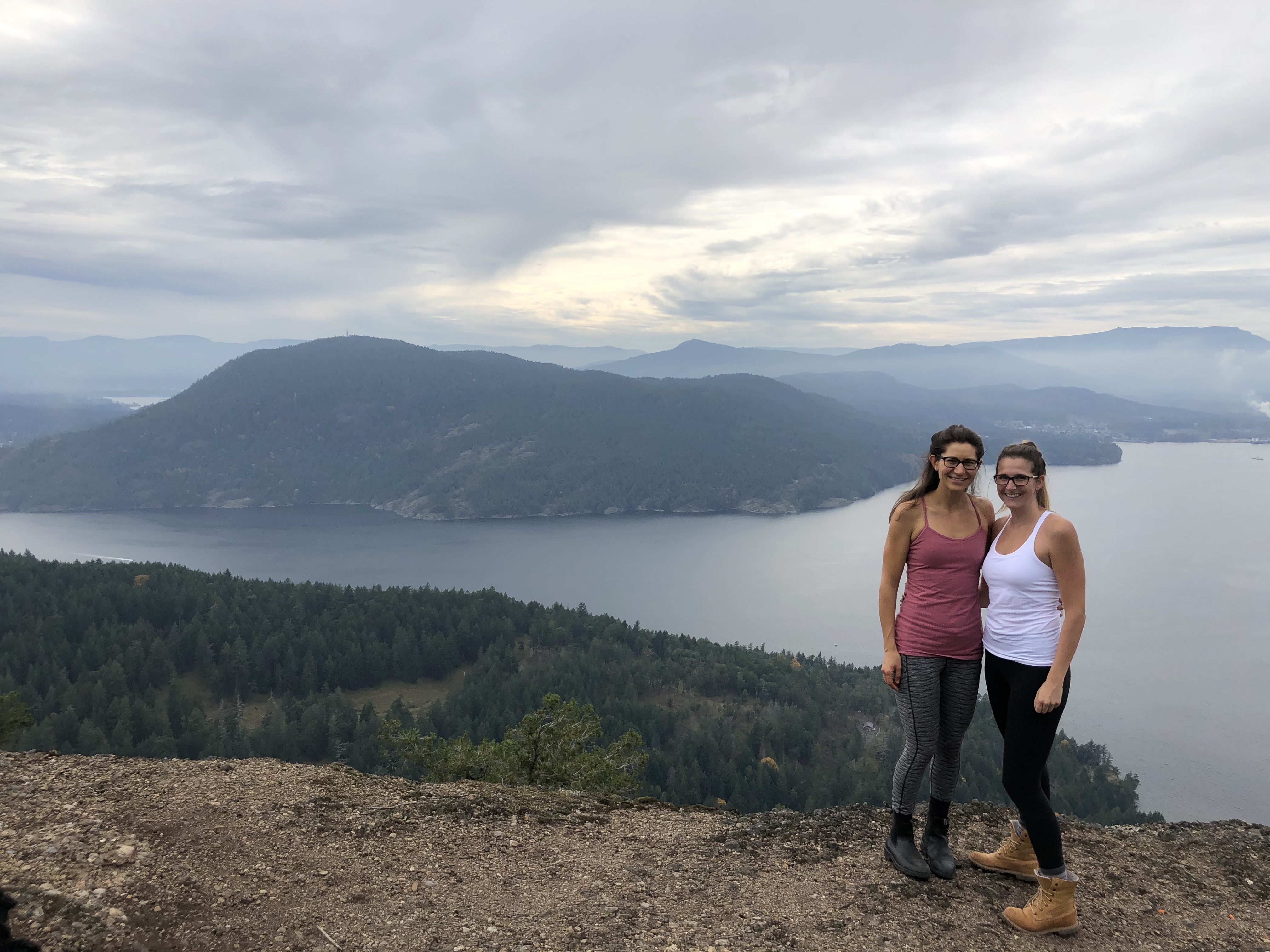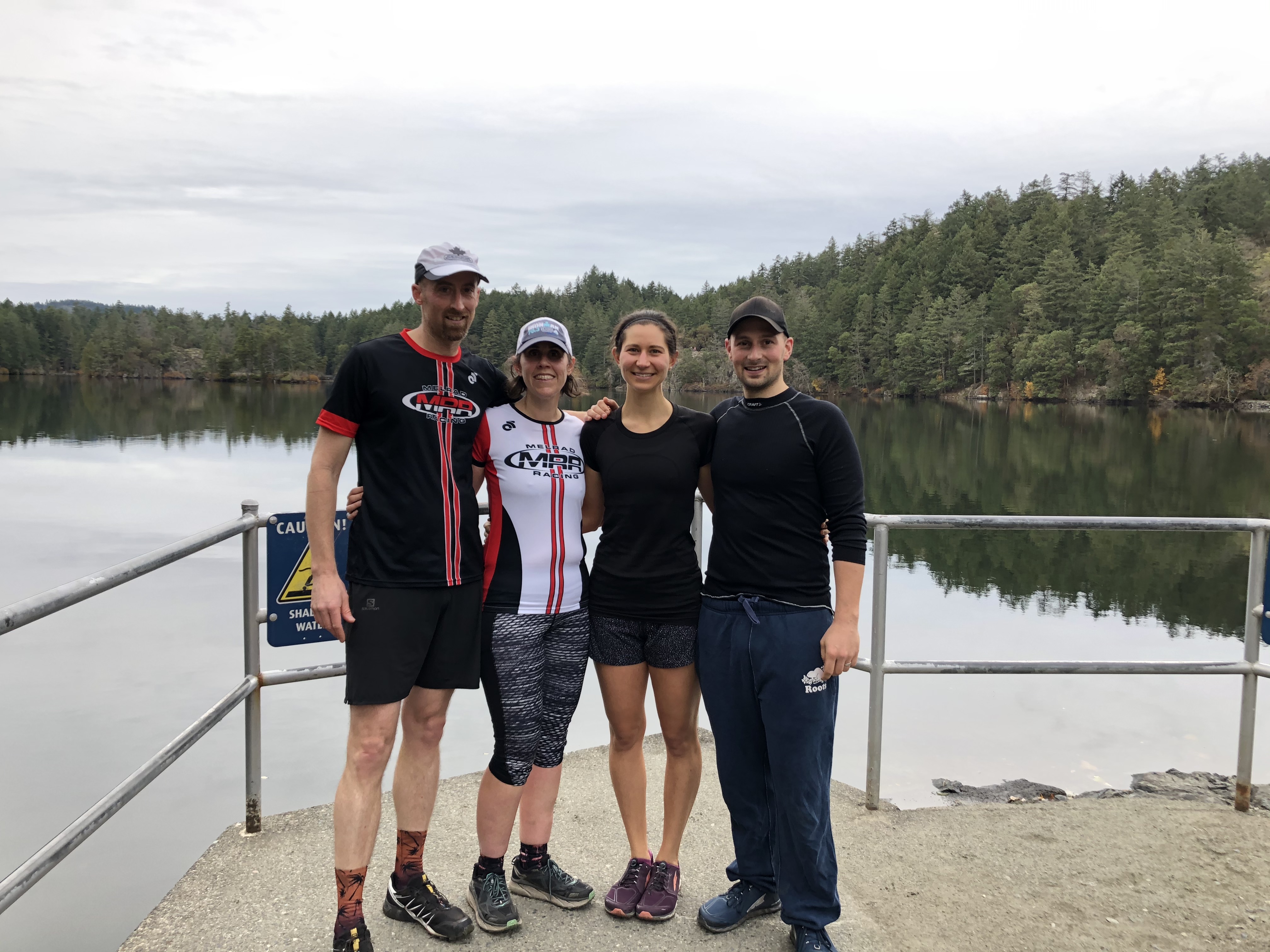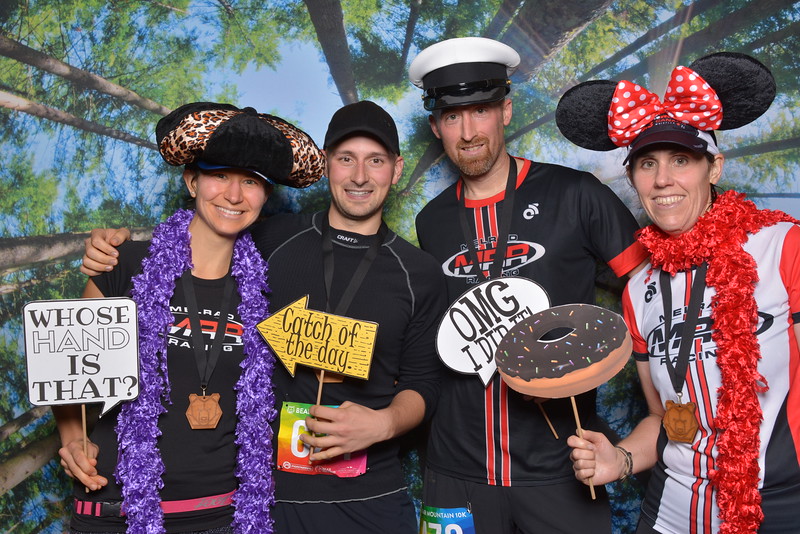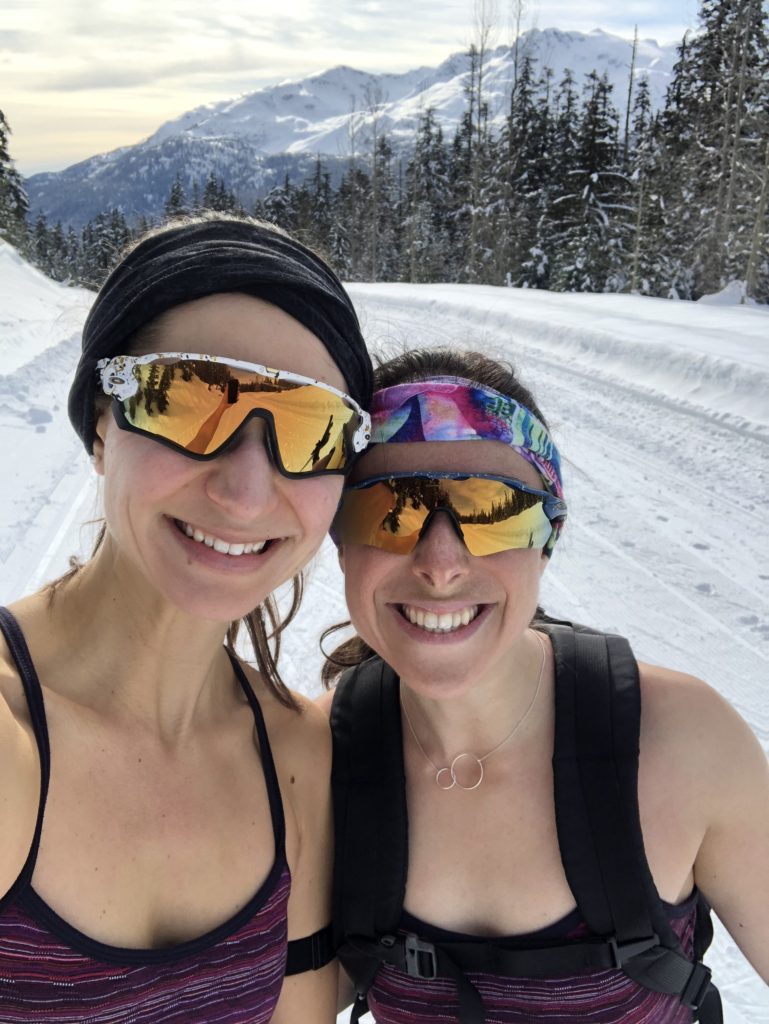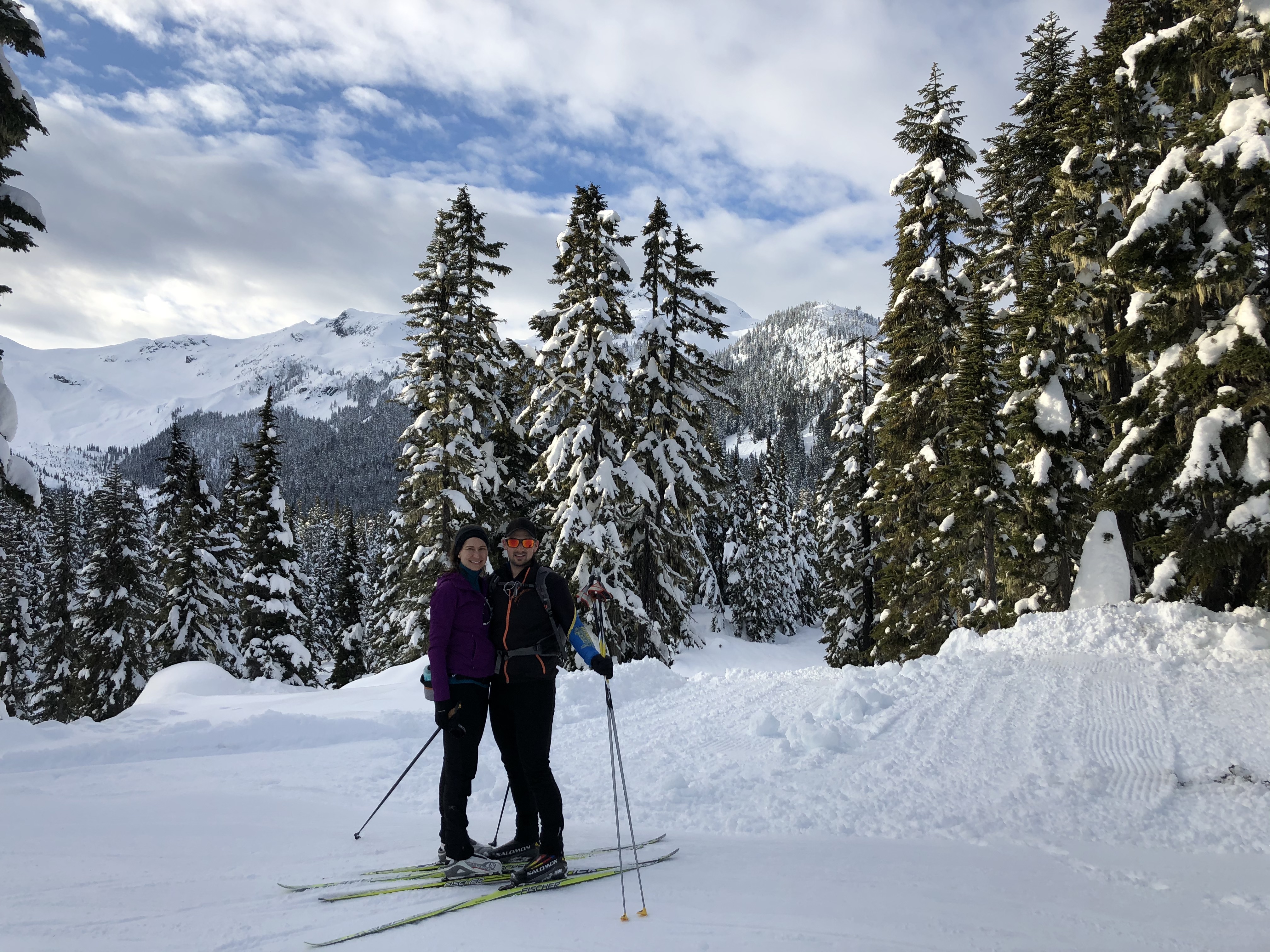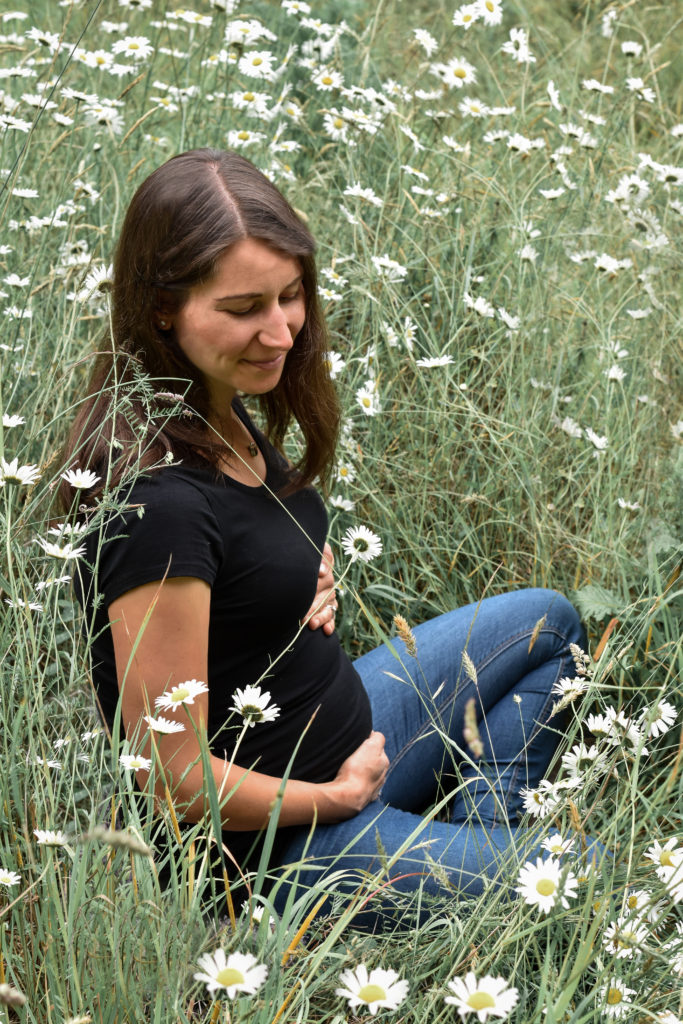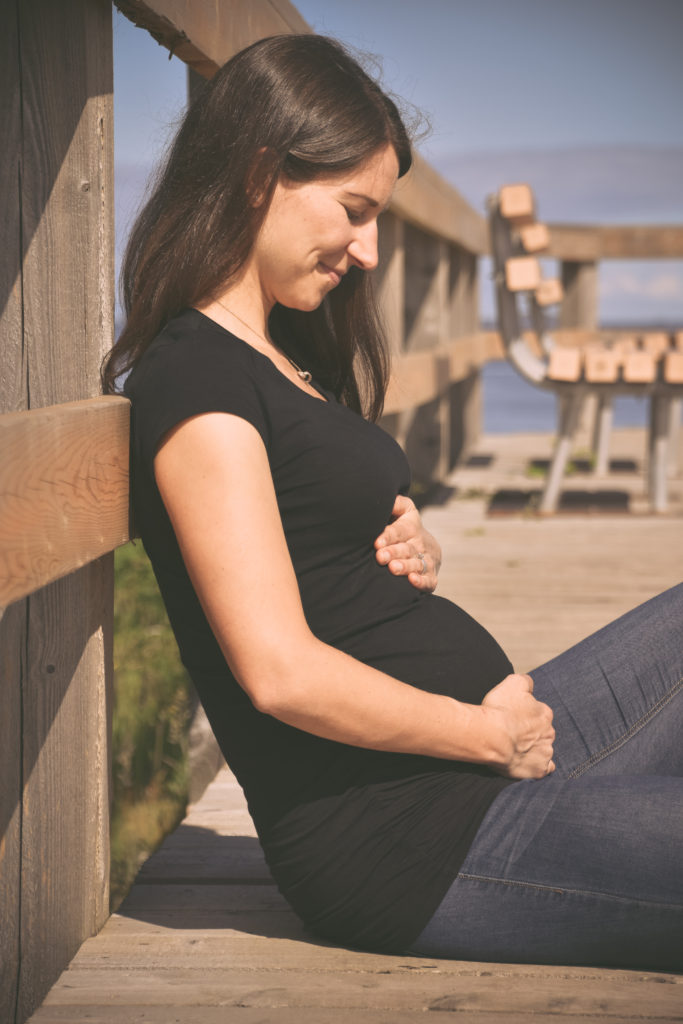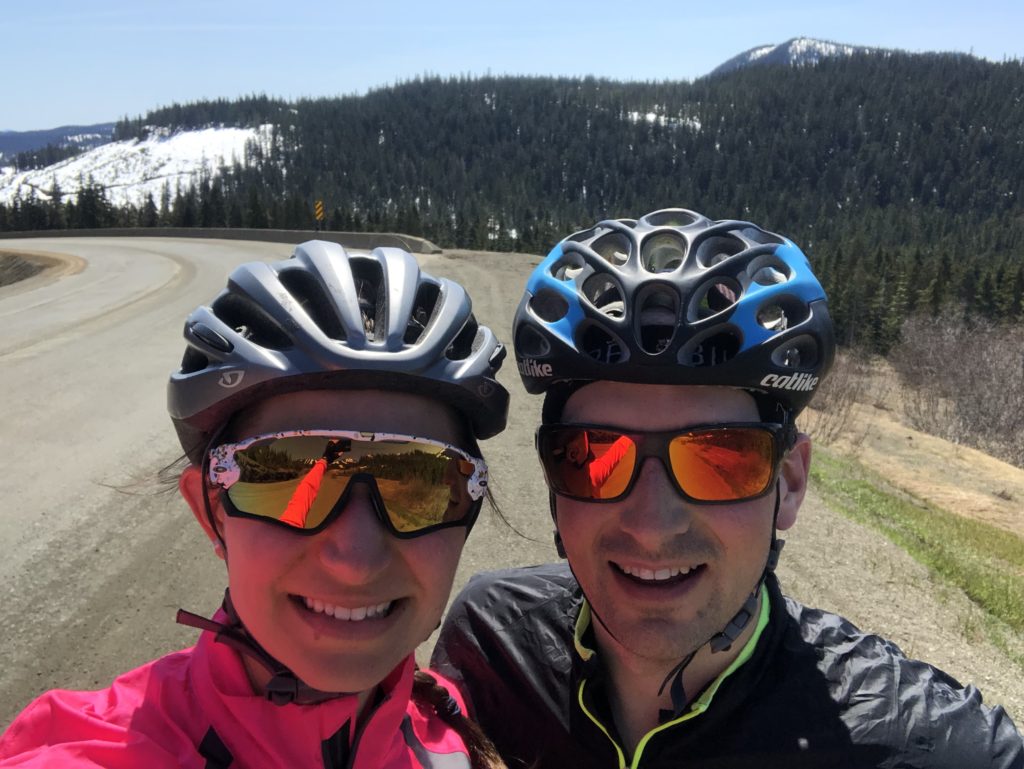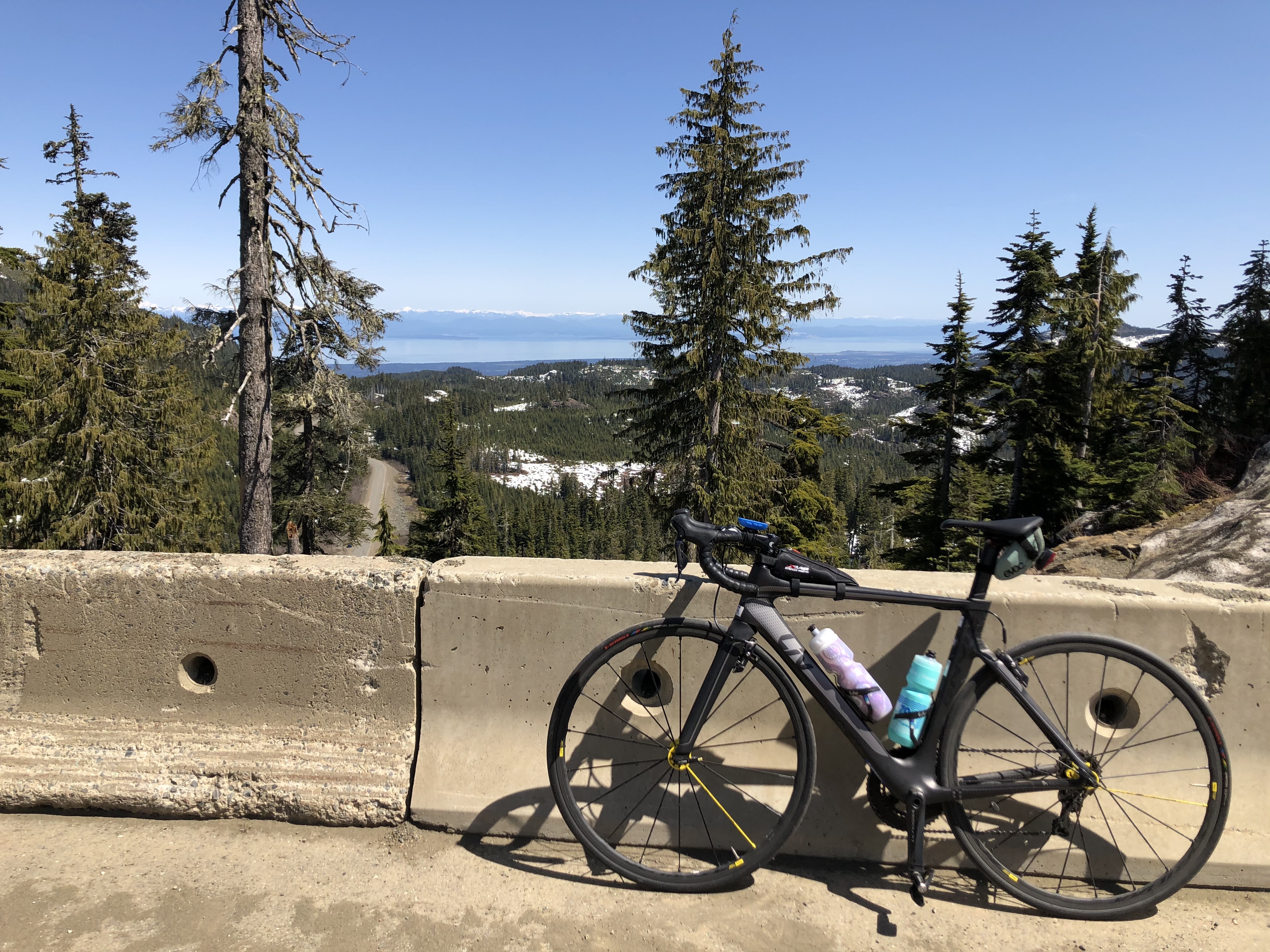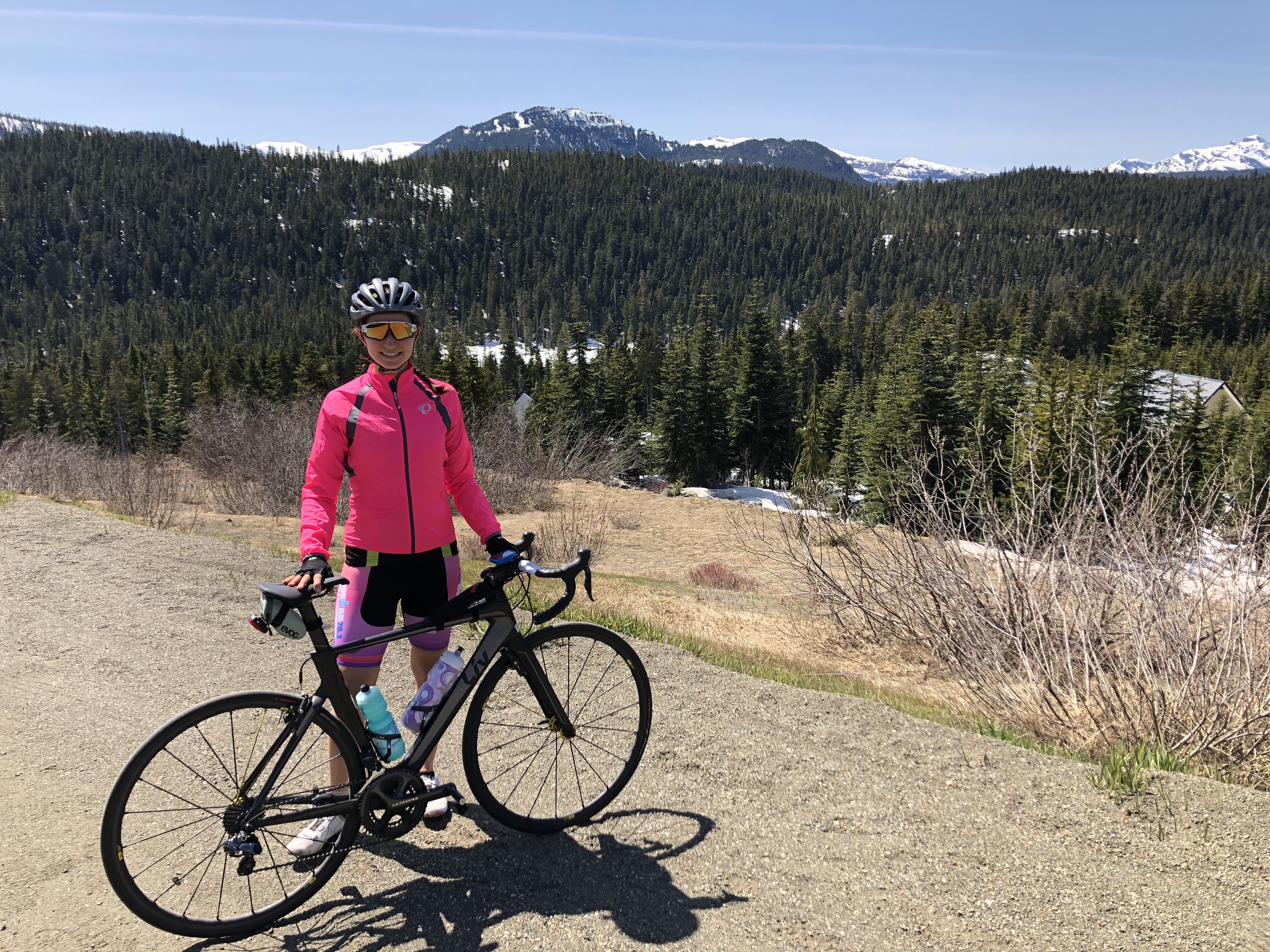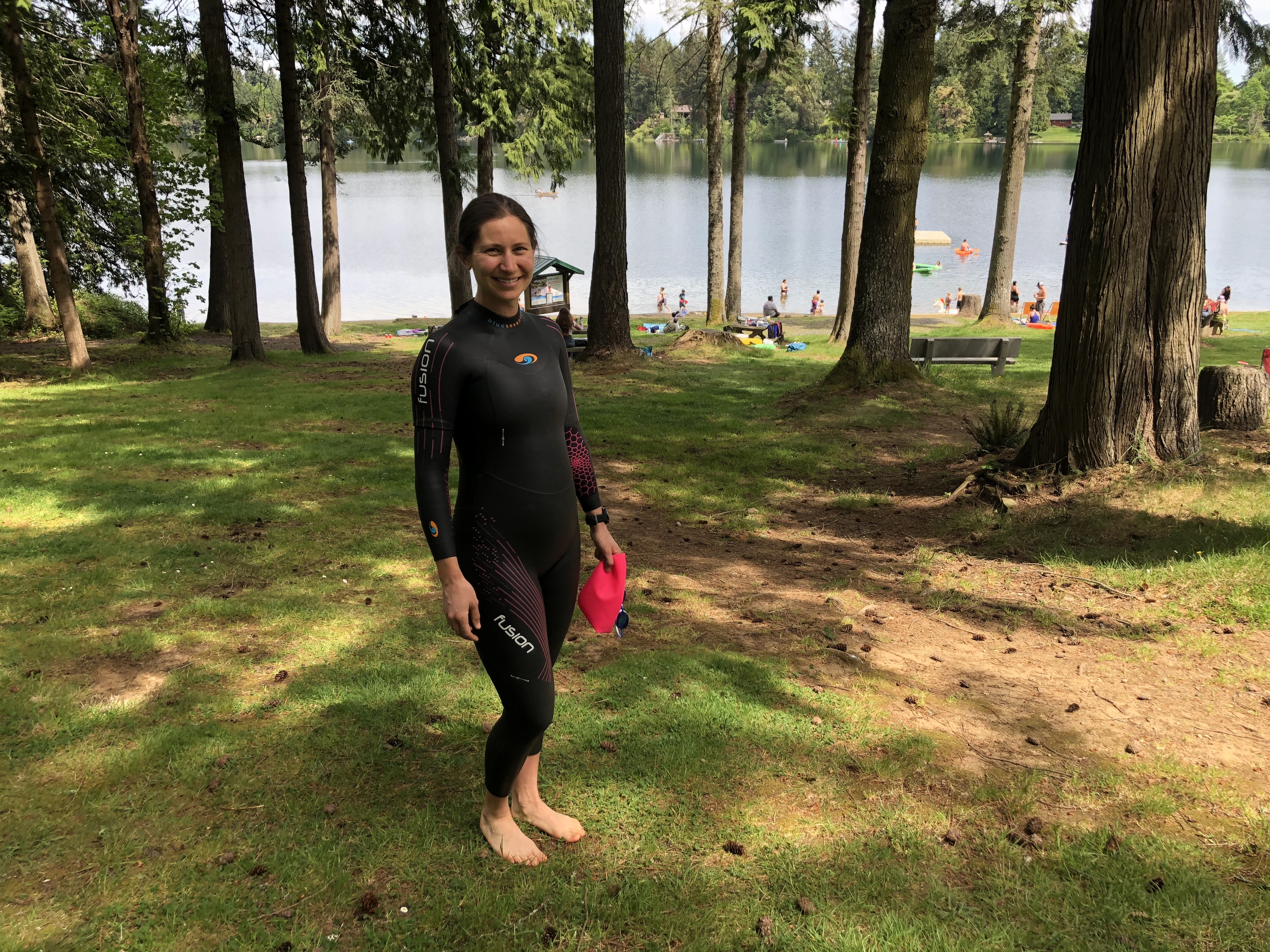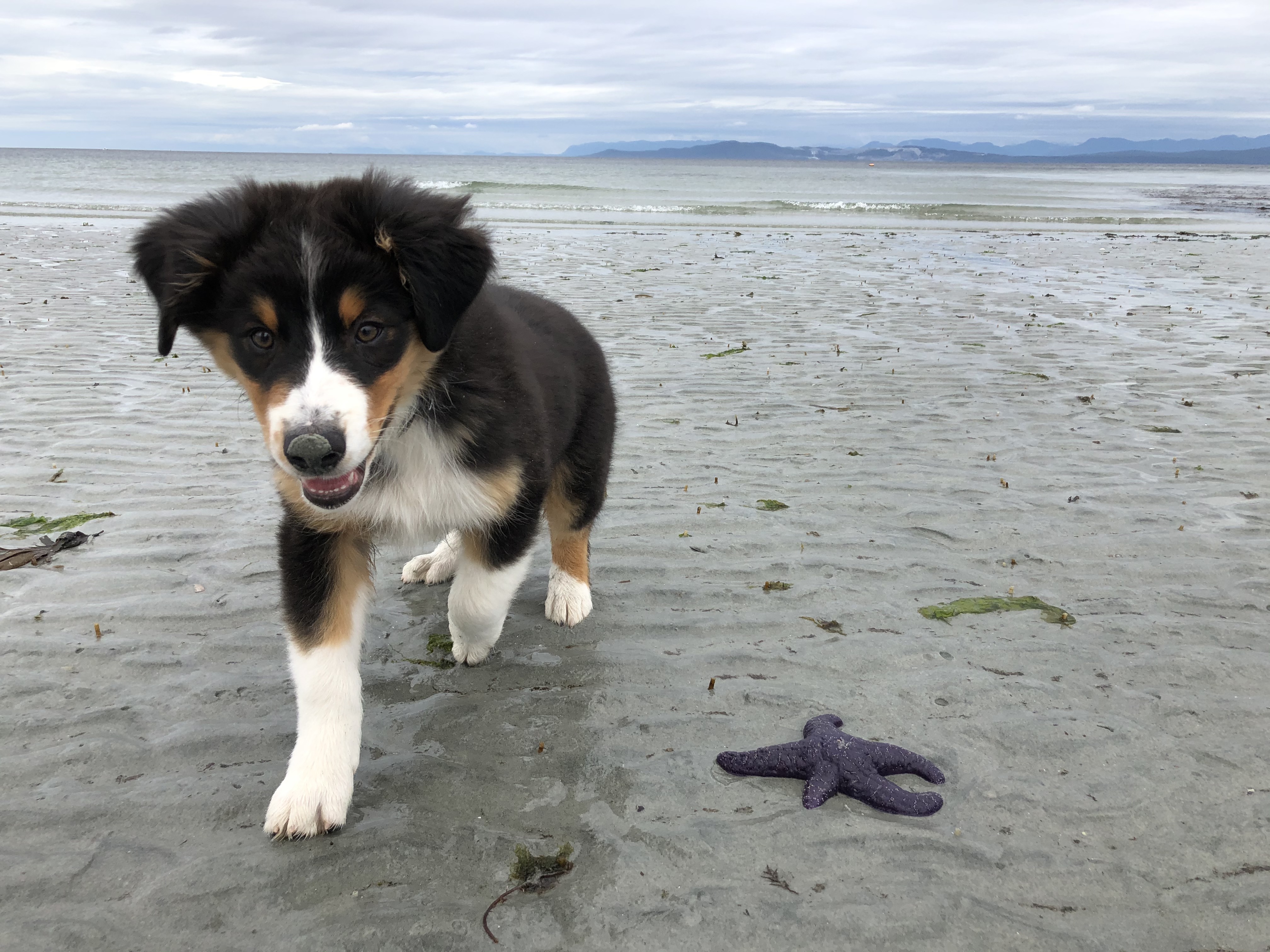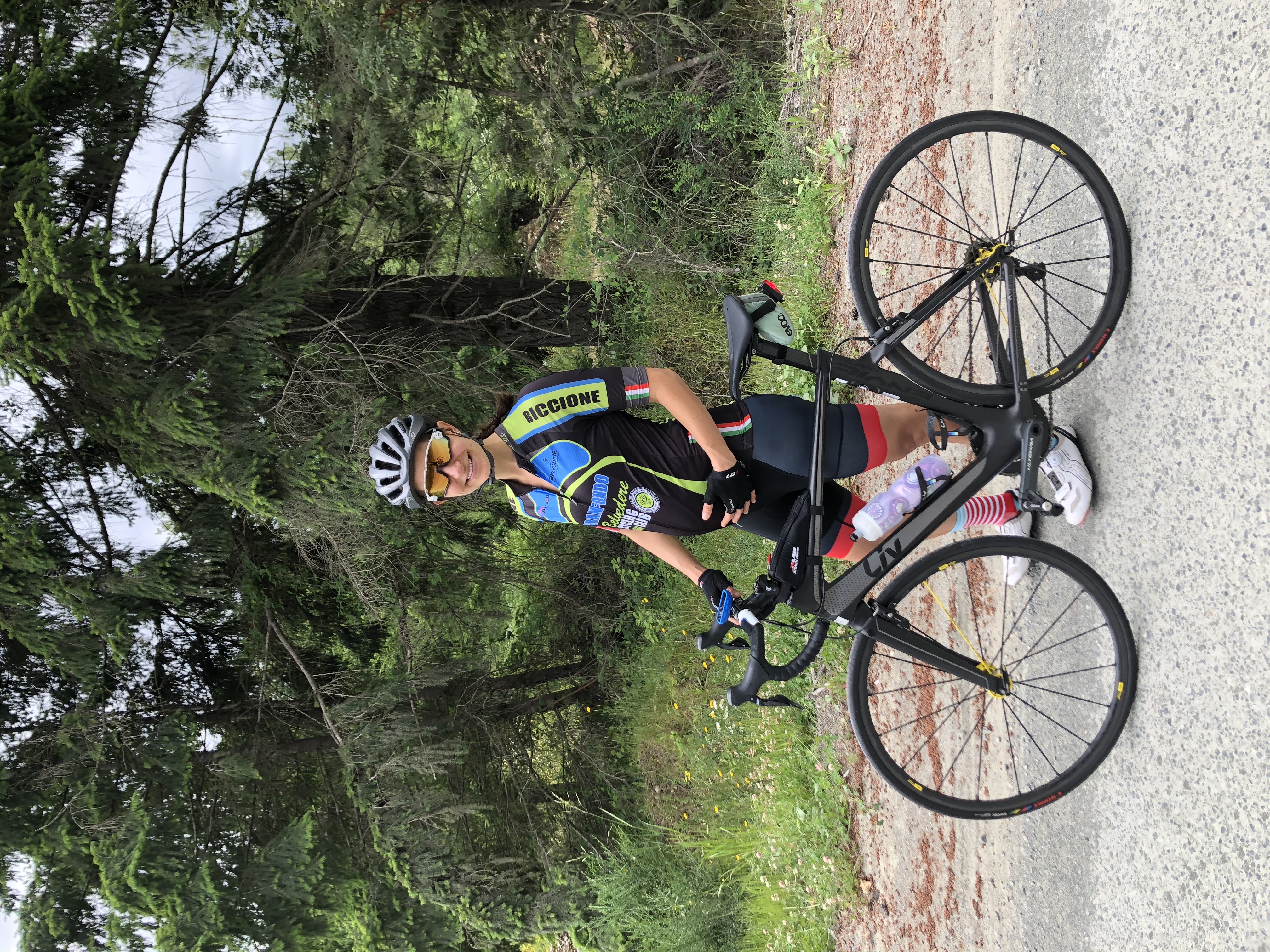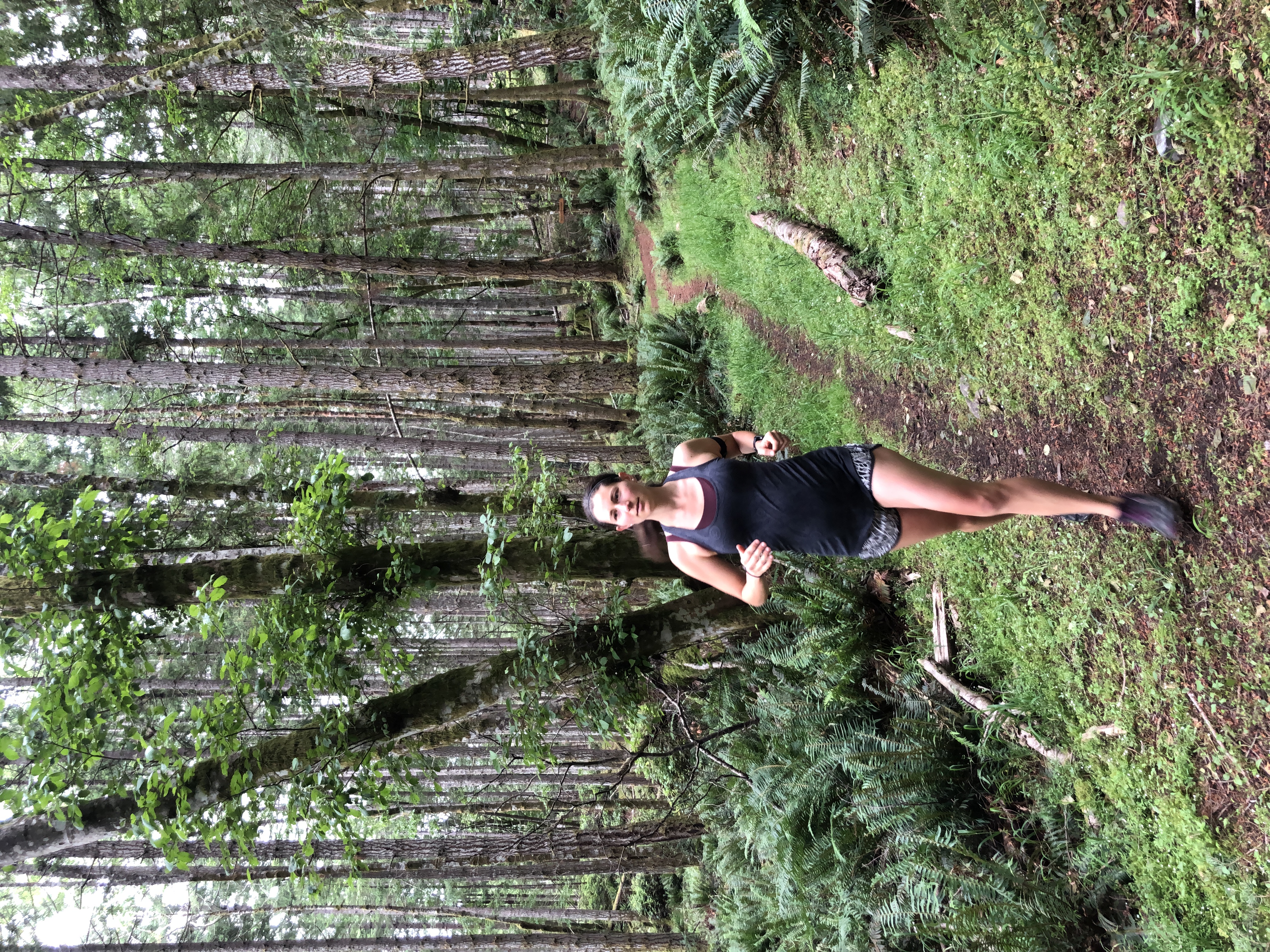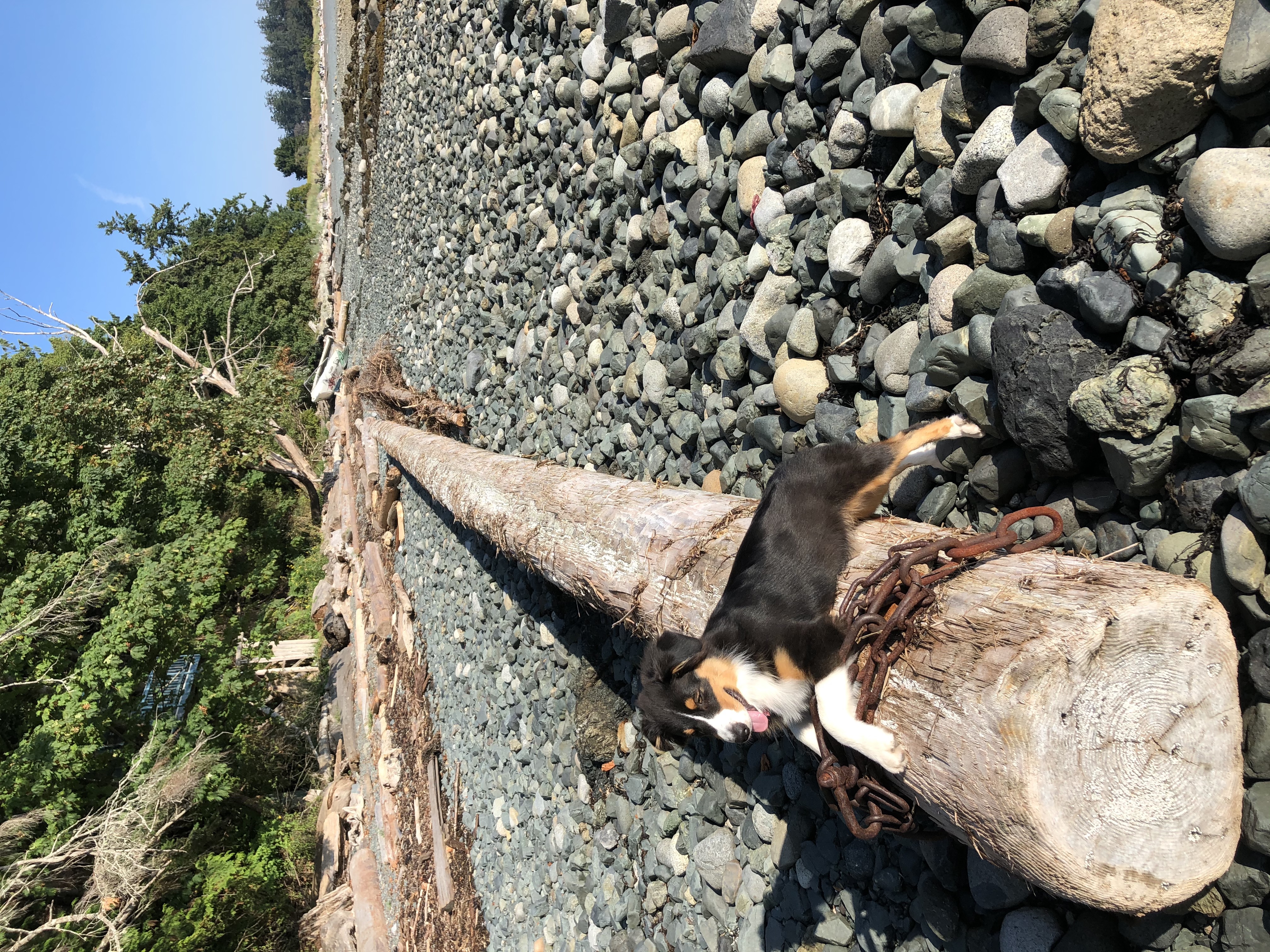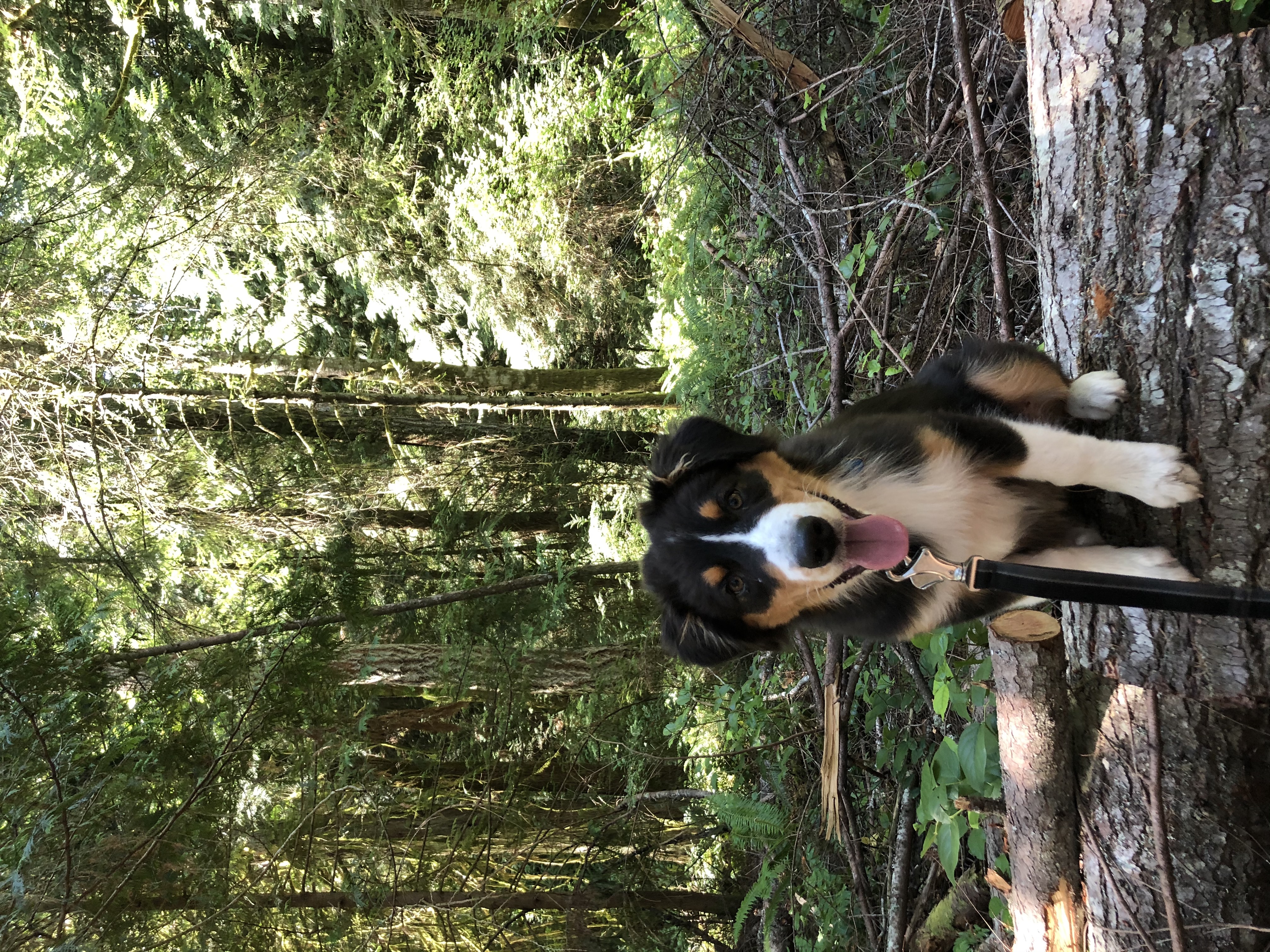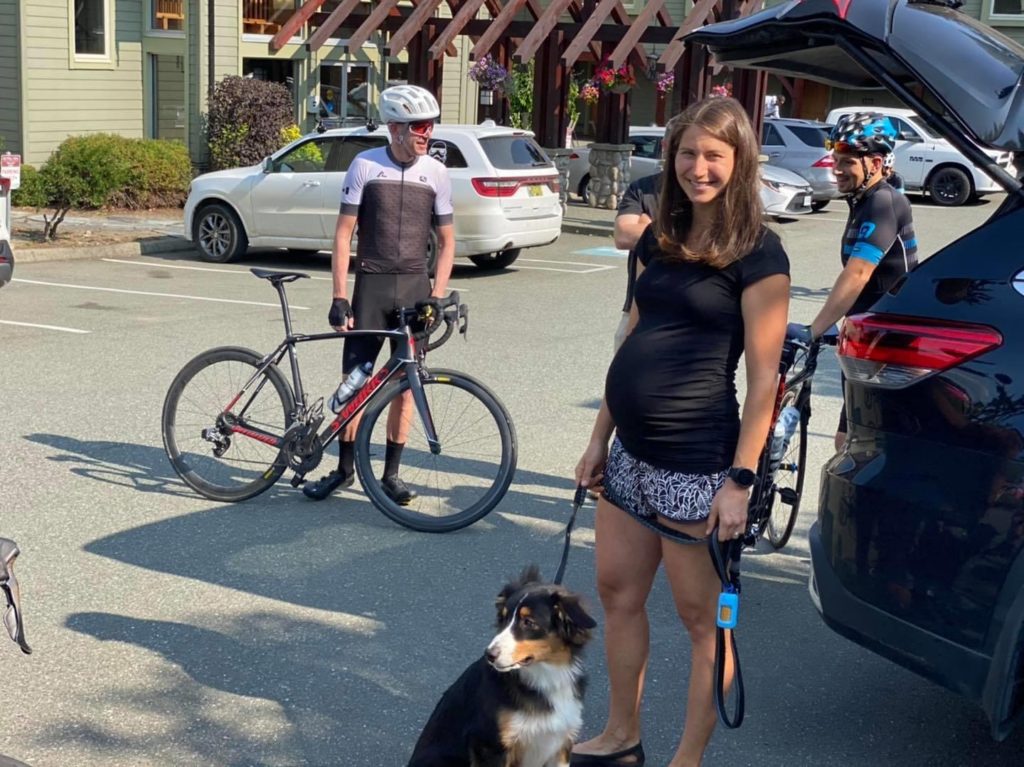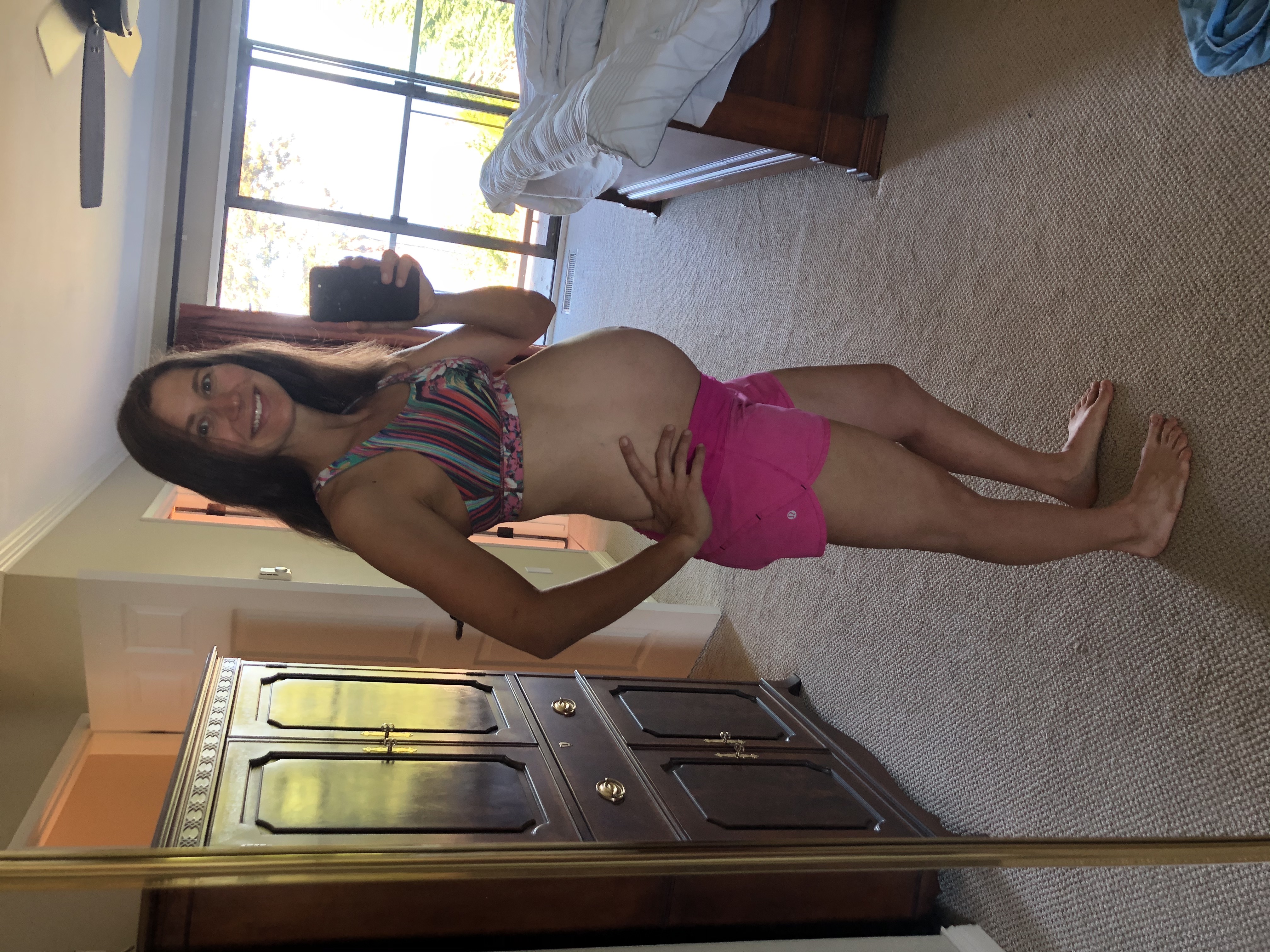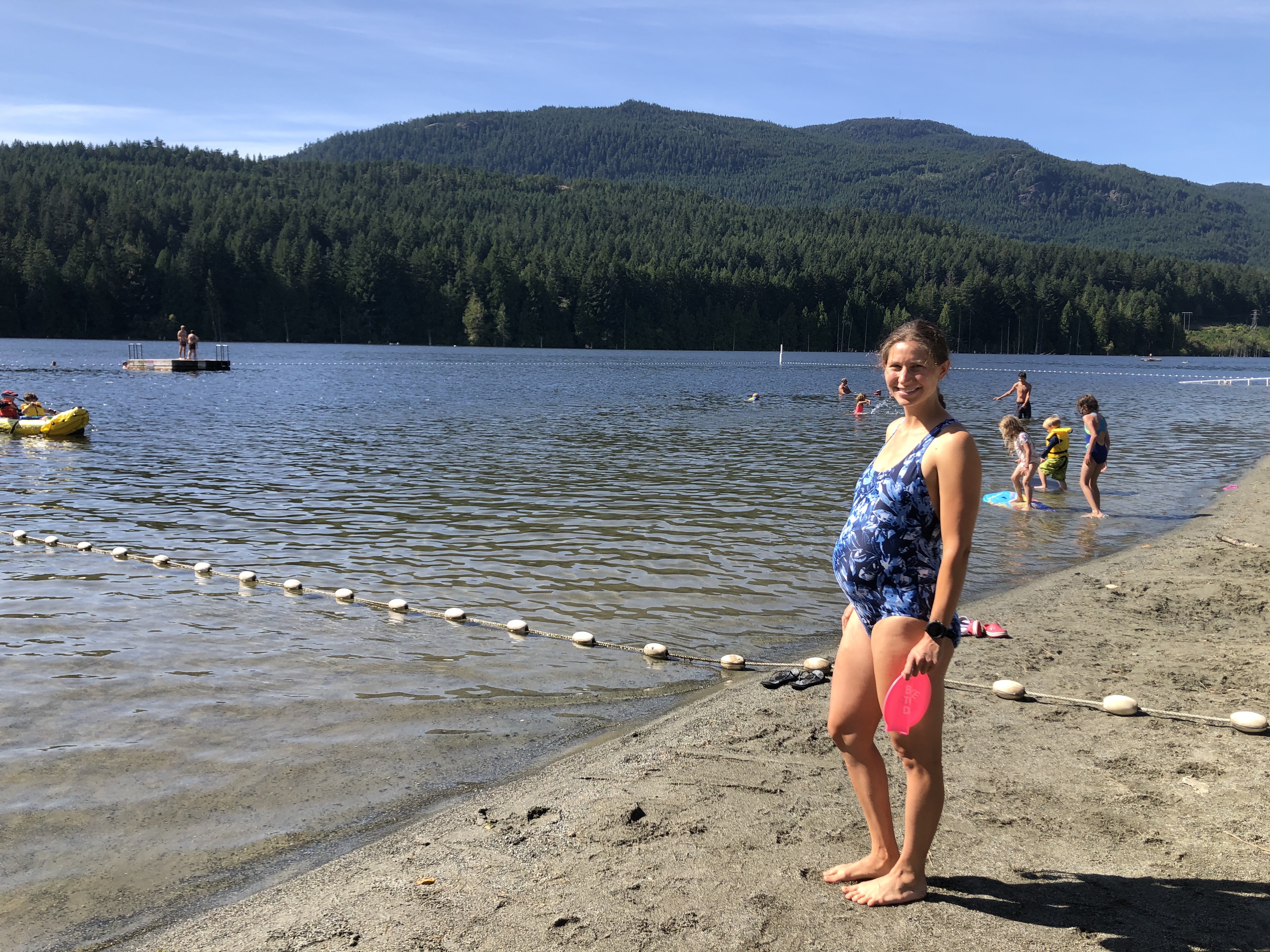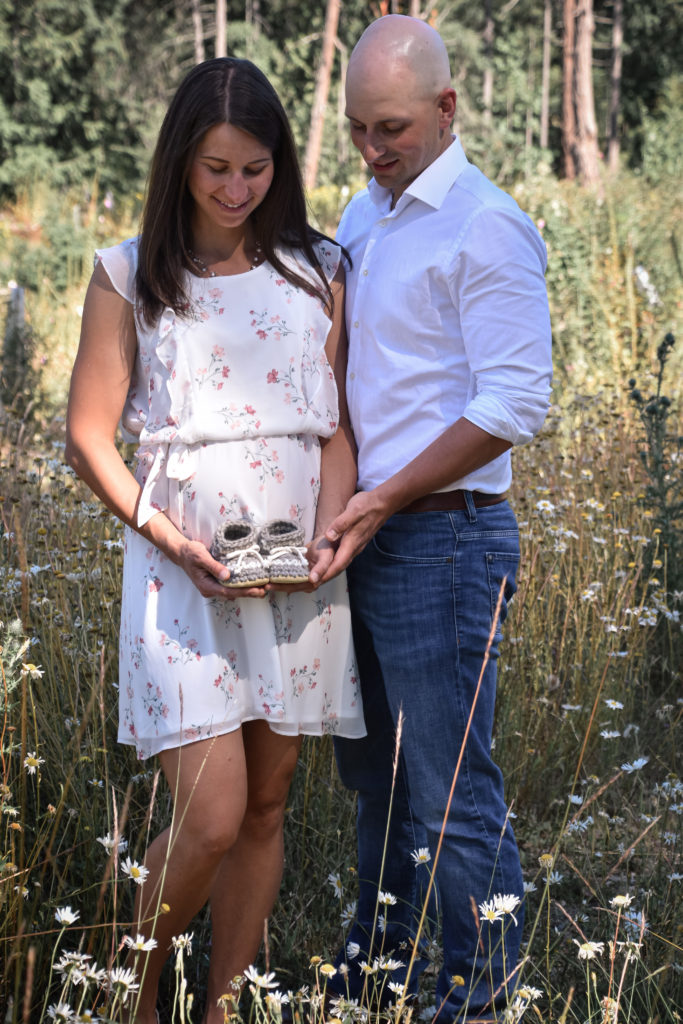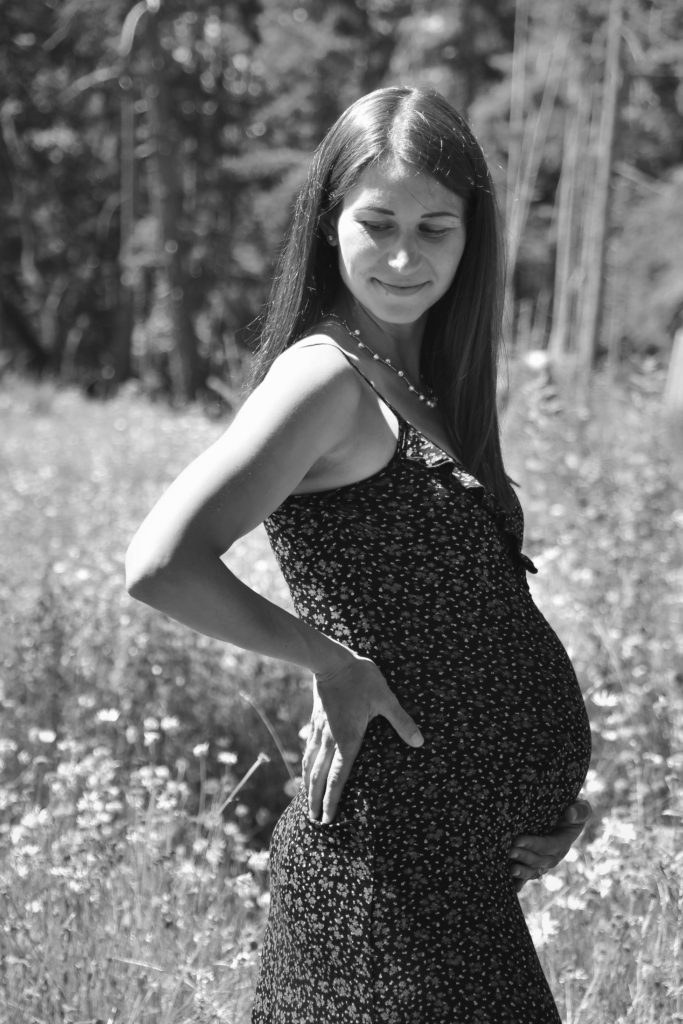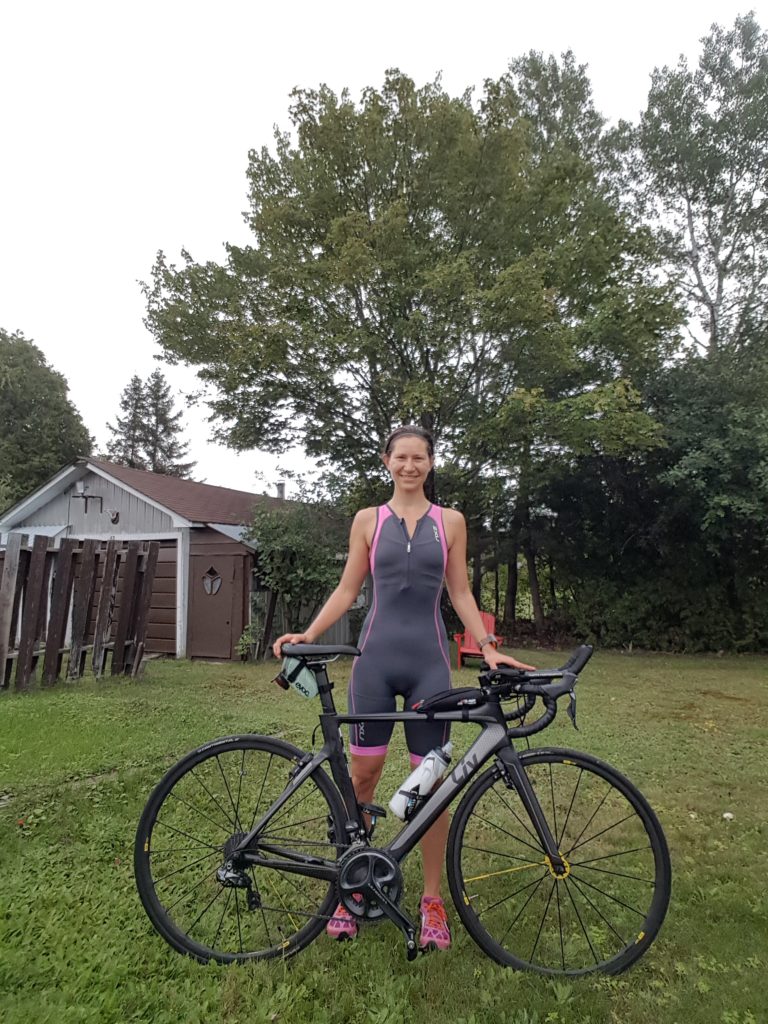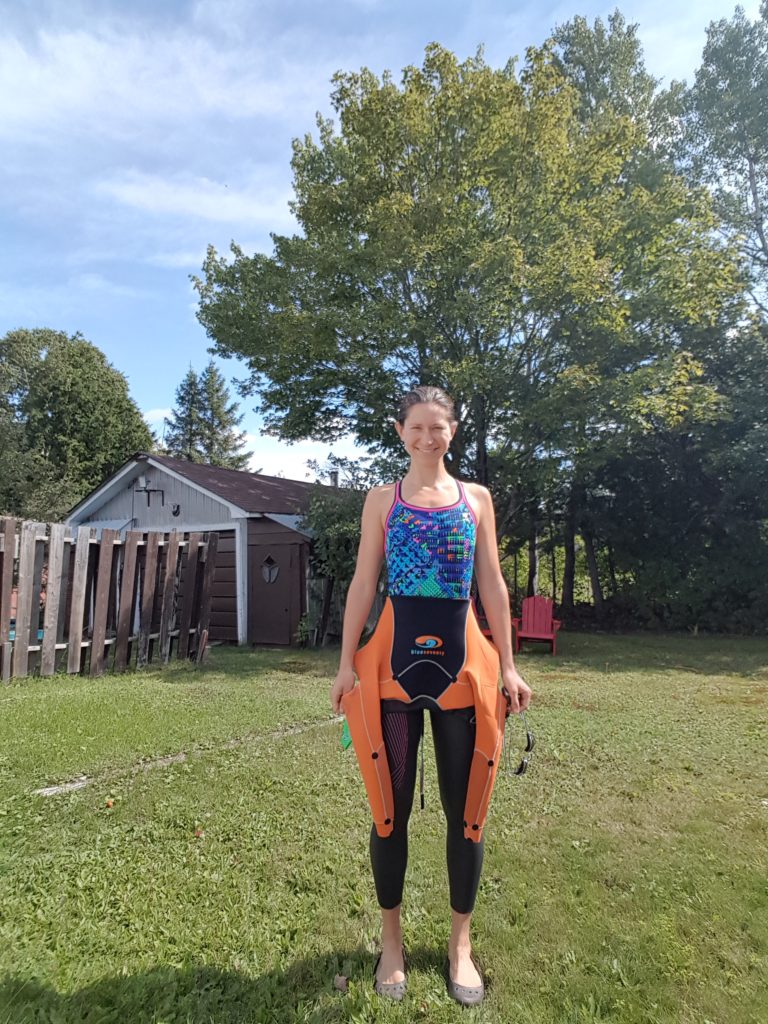I had a memorable and productive race season in 2019. I completed my first full Ironman in Whistler, BC, represented Canada at the ITU World Triathlon Grand Final in Lausanne, Switzerland and raced the Ironman 70.3 World Championship in Nice, France.
With those big races behind me, I took a much-needed break from structured training from September to December 2019. My weekly training volume dropped to 6-10 hours/week and included a mix of swimming, cycling, trail running, hiking and strength training. I participated in a couple of running races with my MelRad teammates, including the Thetis Lake 20k Relay and the Bear Mountain 10k (Canada’s hardest 10k!).
Ever since I can remember, I have always wanted to be a mother. I knew that pregnancy and motherhood would bring new challenges in terms of my triathlon training and racing, but I realized that I wanted to shift my focus from racing to starting a family in late 2019.

Before we started trying to get pregnant, I saw my family doctor and had bloodwork done to check my iron, thyroid and CBC levels. Not surprisingly as a female endurance athlete, my iron was low and I started taking a daily iron supplement.
First Trimester
In January 2020, I found out that I was early into my pregnancy and experienced a whirlwind of emotions. I was ecstatic about having a baby, paranoid that something was going to go wrong and anxious about the years of parenting responsibilities that lay ahead. From 6 to 12 weeks pregnant, I constantly felt nauseous, fatigued and short of breath when exerting myself. This was my least favourite time during the whole pregnancy. I remember thinking that it would be nice to have morning sickness, as my nausea was worse in the morning but lasted all day long. Regarding the nausea, my family doctor advised me to stop taking my prenatal vitamin and iron supplement and to take vitamin B6 and folic acid instead, which immediately helped. I ate frequent, small snacks during the day and indulged my salty, high-carbohydrate cravings and pickled foods: pickles, tomato juice and sauerkraut. My only food aversions were coffee, vegetables and the scent of red wine, all of which I normally love.
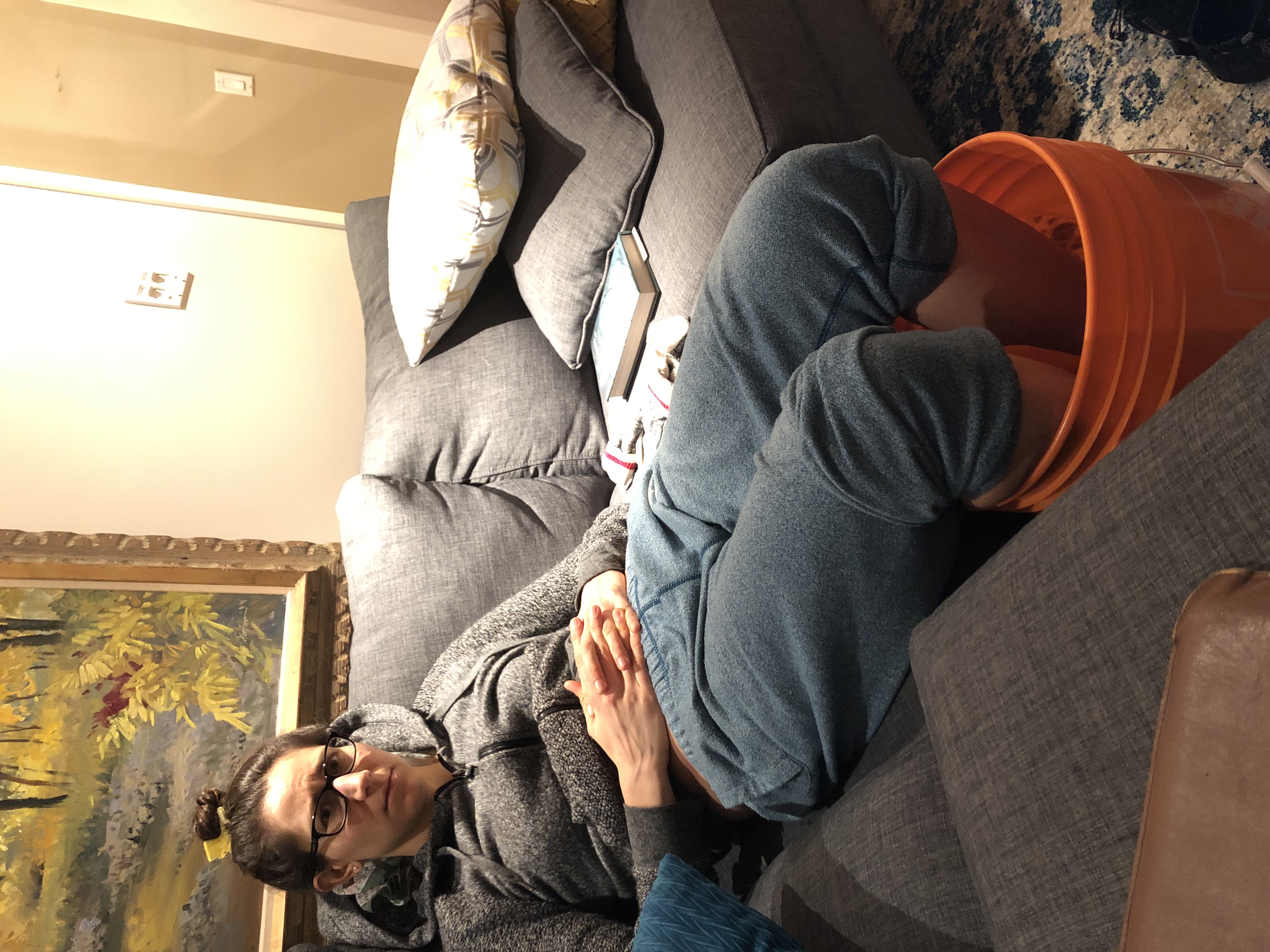
During this time, my motivation for exercising shifted from an athlete’s competitive mindset to maintaining my physical and mental health. I had no idea what to expect or how this pregnancy would affect my training and athletic goals, but looked to my family doctor and coach for training advice. My family doctor labelled me as an “elite athlete” and encouraged me to continue with my training, without any specific guidelines or restrictions.
I shared with my coach, Melanie McQuaid, early on that I was pregnant and she adjusted my training program according to how I was feeling each week. My biggest fear was that I was going to lose all my fitness that I had worked so hard to achieve over the past year. Mel reassured me that pregnancy would be a temporary phase in my life and that many pro athletes returned to sport even stronger and more fit after pregnancy. She likened being pregnant to training with a weight vest on at all times; this analogy comforted me when I felt slow, tired and heavy during many workouts throughout my pregnancy.
During my first trimester, I managed to train 9-12 hours/week. Swimming felt the best, followed by strength training, biking and running. Our local pool is relatively cool, so swimming felt refreshing and woke me up. From the middle to the end of my first trimester, I experienced urinary urgency. Luckily, I do most of my running in a local trail system and could “pop a squat” without risk of indecent exposure. I could only run at an easy pace, and occasionally felt dizzy or short of breath when pushing the pace or running uphill. I enjoyed overgear intervals on the bike, because it was too uncomfortable to get my heart rate up for high cadence work. For a few weeks, the only time I didn’t feel nauseous was when I was exercising! I often needed to nap after work, which is very abnormal for me. I felt physically and mentally exhausted by 8:30-9pm every night, as though someone had given me a NyQuil. In mid-February, my husband and I spent a week skiing in Whistler with my best friend from Ontario and her husband. It felt awesome to be outside all day, to be constantly moving with fresh air blowing in my face.
Second Trimester
At 13 weeks, we breathed a small sigh of relief to have made it through the first trimester. We shared our pregnancy news with our families and closest friends first, then with our colleagues a few weeks later. Everyone was so excited to hear our great news!

During my second trimester, I trained 10-20 hours/week. I was uncomfortable cycling above a heart rate of 130 bpm for long periods of time due to feeling short of breath. I had a lot of urgency and often had to pee after running for 20 minutes. I spoke with my friend (a pelvic floor physiotherapist) during a bike ride and she advised me to relax my deep core muscles and focus on diaphragmatic breathing while exercising. She said that most pregnant athletes tend to have an overactive, tight transversus abdominis that increases pressure on the bladder. This strategy immediately helped my urge to pee! She also advised me to focus less on core strengthening and more on gluteal strengthening, due to the pelvic changes that occur throughout pregnancy and difficulty activating those muscles postpartum.
As the weeks went by, my energy levels slowly increased and I experienced little to no nausea. Due to the spring 2020 COVID-19 lockdown in BC (mid-March to mid-May), I was only working a few half-days per week from home offering physiotherapy via telehealth. Rod and I had time to do a ton of cycling and explored around Vancouver Island. When my bump grew too large for my own cycling jerseys, I rotated between two of Rod’s jerseys and seriously stretched out two of my own pairs of cycling shorts.
Since I was unable to race in 2020 (both due to COVID-19 restrictions and being pregnant), I told my coach that I wanted a physical challenge to reassure myself that I was still strong and to mentally prepare myself for my upcoming endurance event: labour and childbirth. In early May (21 ½ weeks), Rod and I did a 3-hour bike ride from Courtenay up Mount Washington, our local ski hill. When we finally started riding at 11:30am, it was already 25°C. Even before getting pregnant, I preferred exercising in cooler temperatures and this was only amplified during pregnancy. I worried that I would overheat or get dehydrated, and I promised myself that I would stop or slow down if I felt unwell or too exhausted.
After a 30-minute warm-up, we began steadily climbing up the paved road leading to Mount Washington. My plan was to ride around 170-180W, depending on how I felt. With my 10-12 lb weight gain, I had to push 200-220W just to get up the 13-15% grade section at the bottom of the climb! I was sweating profusely after 15 minutes of climbing and was worried I would overheat, but I felt a bit better once the grade eased and we felt the odd breeze. It actually felt great to physically suffer again and push myself after not having raced since September 2019! I didn’t take any rest breaks at all, just kept riding steady and tried to keep a steady output the whole climb. It took me just over 90 minutes to ride up the 18 km main segment with 1100m of elevation gain, with an average power output of 190W and average heart rate of 147 bpm (check out my detailed ride here!). After a quick snack, pee break and photo op at the top, we carefully descended back down. I had to remind myself that I was carrying a baby in front of my body, so I slowed down a bit, but still felt comfortable descending up to 65 km/h as long as the road was smooth and clear. I was convinced that I was prepared for labour.
On May 10th, I met a couple of my MelRad teammates at nearby Fuller Lake for our first open water swim of the season. The water had warmed up enough to brave the cold with my snug-fitting wetsuit and I returned to swimming after an 8-week hiatus due to the COVID-19 pool closures. I felt like a fish out of water for the first couple hundred meters and had to adapt to a new body position in the water. Nevertheless, I had a newfound appreciation for the water and it felt amazing to be swimming again.
Around 20 weeks, I started experiencing some reflux when exercising too soon after eating and was forced to exercise after fasting for a few hours. At 25 weeks, Rod and I brought home Bear, an adorable 13-week-old Australian Shepherd puppy. Thankfully, he slept through the night from day one! He was a perfect addition to our growing family and a distraction from pregnancy-related discomfort.
Third Trimester
During my third trimester, I trained 9-13 hours/week of a combination of hiking, swimming, strength training, road cycling and running. I loved swimming while pregnant and frequently swam laps around Westwood Lake, a gorgeous nearby lake. I continued to ride my bike during the third trimester. I swapped out the stem on my bike for one on a 30° angle to keep me more upright, which made room for my growing belly and made it easier to breathe. I also enjoyed lifting weights twice per week, as I wanted to maintain as much muscle mass as possible; my favourite circuit was 3-4 rounds of: Romanian deadlifts, goblet squats, lateral step-ups, bicep curls to overhead presses and suitcase carry.
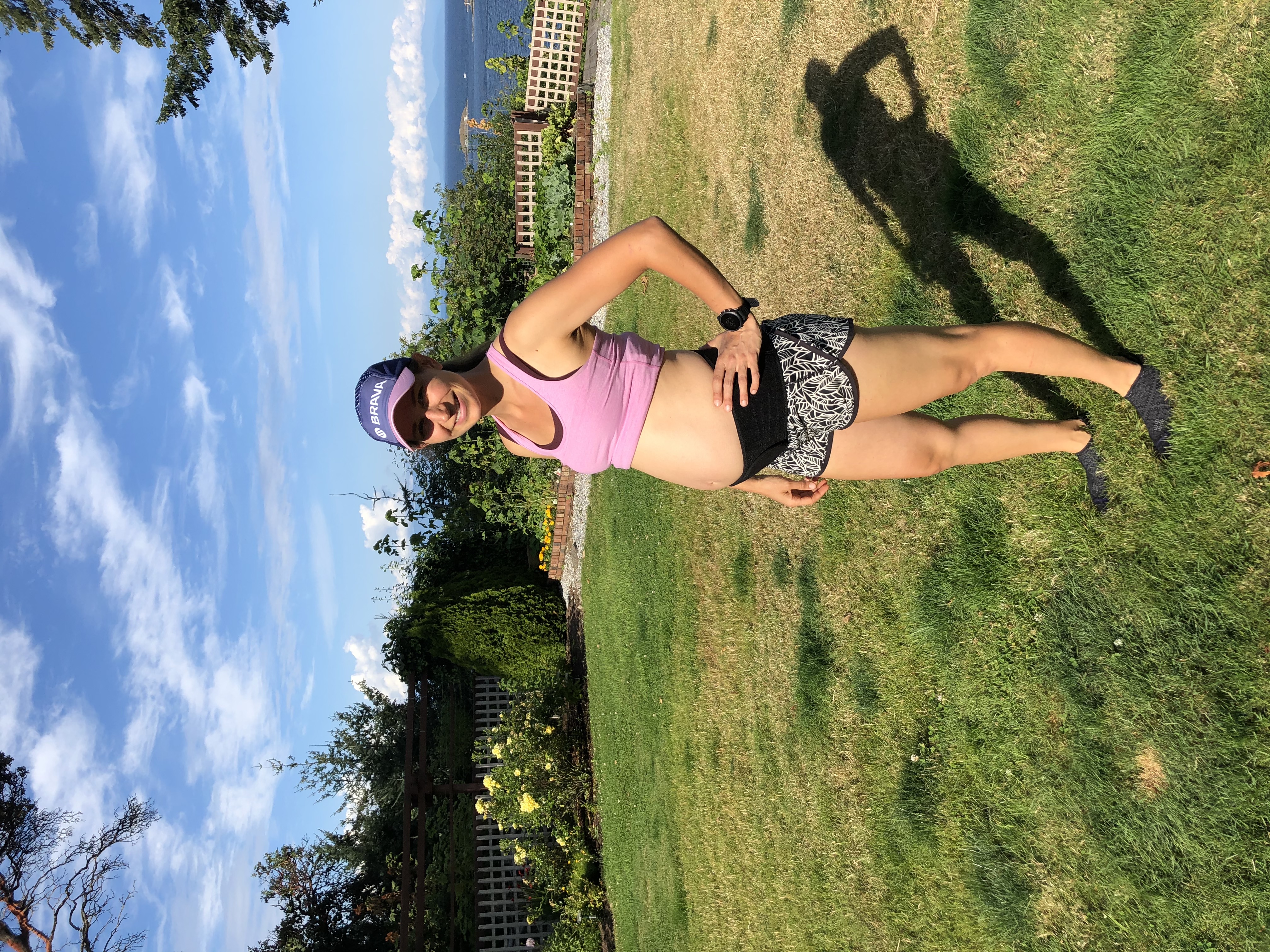
At 28 ½ weeks, I completed the BRAVA virtual triathlon challenge: an Olympic distance triathlon race over a 3-day weekend. I was selected as a BRAVA ambassador for 2020 (and 2021!) and wanted to complete it for fun. I had agreed to take it easy if I wasn’t feeling great during each activity. I was particularly happy with my 40 km ride, where I managed to maintain 190 W and an average heart rate of 143 bpm for an hour and 20 minutes on rolling terrain (there is nothing flat in Nanaimo!). I was pleasantly surprised that my power output was similar to that during a half Ironman; maybe I wasn’t losing as much fitness as I thought I was. I started wearing the Upsie Belly Bandit for running that weekend and it made a huge difference in relieving pressure off my bladder and helped compress my pelvis to give me a bit more support. My only regret is not starting to wear it earlier!
My reflux continued to worsen throughout my third trimester and I regularly took TUMS before exercising, which helped a great deal. I reluctantly made dietary changes, and avoided irritants such as ketchup, hot sauce, tomato sauce, excessive cheese, onions, garlic and sparkling water (my beverage of choice).
At 31 weeks, I started to feel mild pressure and heaviness inside my pelvis and my bladder felt super full when running downhill, but still felt good enough to continue running for a couple more weeks. At 33 weeks, I suddenly started to feel discomfort in my tailbone, glutes, hamstrings and calves when standing upright. It felt like the baby’s head was starting to put more pressure on my pelvic area and possibly impinging on my lower lumbar nerve roots. It was an easy decision to stop running and shift my focus to other activities. Unfortunately, hiking also became uncomfortable, as my lower back would hyperextend while hiking downhill and simultaneously holding Bear’s leash as he was pulling. Nonetheless, Bear needed at least an hour of walking every day so I endured to make sure he got a workout every day.
At 36 weeks, I started occasionally experiencing mild cramps or Braxton-Hicks contractions while swimming. They weren’t painful, but slightly uncomfortable as my entire belly would feel rigid for a few seconds. When swimming alone, I made sure to attach the My Float bag to my waist so I could rest and hang onto it if I needed a break. Much to Rod’s dismay, I continued to ride my bike outdoors up until 38 weeks, when I officially started my maternity leave. We don’t have air conditioning and I found myself easily overheating all throughout pregnancy, so I enjoyed the breeze and changing scenery of riding outdoors as opposed to riding on the trainer. I rode much more cautiously as the weeks progressed.
I managed to swim my usual 1600m loop in Westwood Lake up until 3 days before giving birth and did a moderately strenuous 90-minute hike and lifted weights while I was unknowingly in early labour the day before going to the hospital.
Being pregnant was an amazing, life-changing experience for me. It was the first time I have ever felt that I was not truly in control of my own body. As an athlete, you get accustomed to the direct impact of training on how your body feels and performs. During pregnancy, there were so many other factors (hormones, physiology, anatomy) that would affect how I felt on any given day. Training during pregnancy provided me with structure and routine (this was crucial for me during a pandemic!), a sense of purpose and an appreciation for what my body could do. I learned what it meant to truly listen to your body and not only respect, but admire the incredible changes that occur when you are growing a tiny human inside of you!
